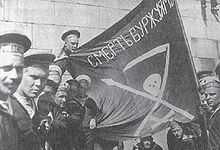Anarchism in Finland
Anarchism in Finland dates back to the early revolutionary movements of the 20th century, seeing organized activity begin in the 1960s.
For example, the long-term chairman of the Finnish Seamen's Union, Niilo Wallari, and the musician Hiski Salomaa were both members of the Industrial Workers of the World (IWW).
When Kaapo Murros, who had translated the works of Russian anarchist Peter Kropotkin into Finnish, returned from North America to Finland in 1909, he presented his party colleagues at the SDP Assembly in Kotka with an anarcho-syndicalist line, one skeptical about the possibilities of class struggle from parliament and proposed some kind of decentralized municipal and cooperative strategy.
Yrjö Sirola, along with others, attacked such ideas at the meeting, emphasizing the importance of parliamentary work and the fundamental flaws of the general strike tactic.
Otto Wille Kuusinen's pamphlet Anarchy and the Revolution, published in Helsinki as early as 1906, reflected the SDP's general attitude towards anarchists.
In the booklet, a then-deputy member of the SDP's party committee harshly criticized those on the path to violence and individual terrorism and condemned such practices as "anarchist".
After the abolition of the first Red Guards established in connection with the 1905 Revolution, several underground groups began armed action against the tsarist rule in Finland.
However, the anarchist meetings continued at Senate Square throughout the summer, even though the authorities had interned Boldt in Niuvanniemi Mental Hospital.
[4] In the summer of 1917, the Russian soldiers who stayed in Helsinki established a so-called "Anarchist Club" in the factory located on the site of the present Post Office.
Kronstadt refugees were initially locked up in concentration camps on the Karelian Isthmus, after which some returned to Soviet Russia and others remained permanently in Finland.
[8] In 1933, a poem by the anarchist Kaarlo Uskela, who died eleven years earlier, Pillastunut runohepo was seized and burned by a court decision.
The anarchist Winnie the Pooh Society also started its activities in Helsinki, where the fight of good against evil was discussed with examples provided by fairy tales.
In the autumn of 1996, the anarcho-syndicalist Solidarity Trade Union was established, partly as a competitor to the SAL, but it also ceased to exist in the early 2000s.
[12] In December 1981, member of the French anarchist terrorist group Action Directe Lahouari Benchellal, kwas arrested for forging traveler's cheques in Helsinki, Finland.
Even the platinum-class artists like Apulanta use the circle-A in their symbols, but the anarcho, hardcore and crust punk scenes, which took a stronger stand, also have their own loyal supporters.
[18] Today, militant antifascists are organized under the name Crow Network and have fought with the Finnish Resistance Movement (SVL).
[22] Police estimate that Finnish Antifa's primary targets are the Nordic Resistance Movement and the Soldiers of Odin.


